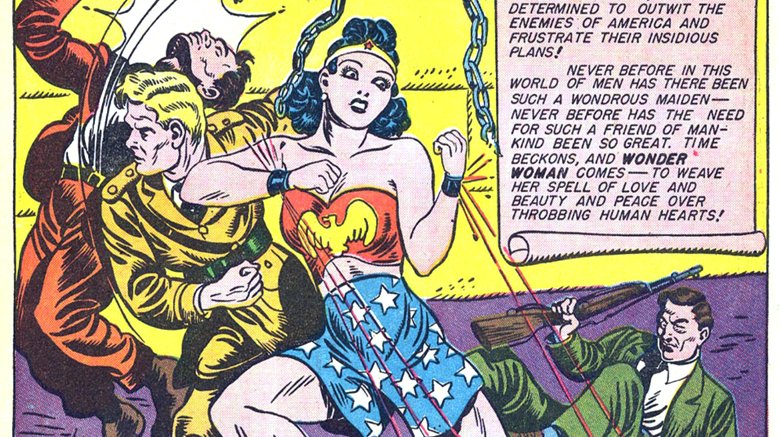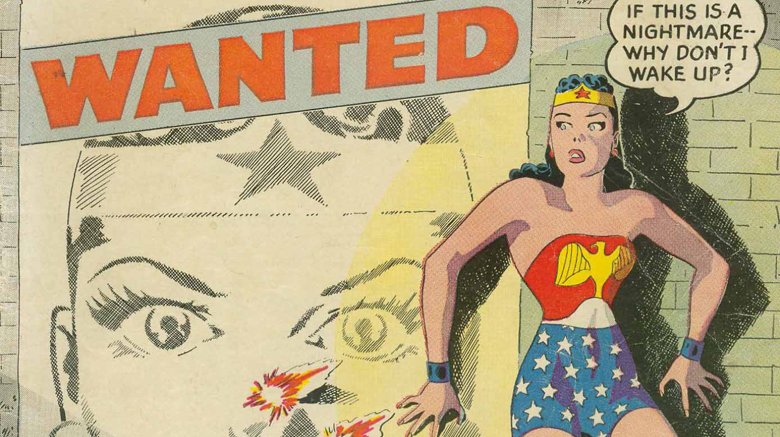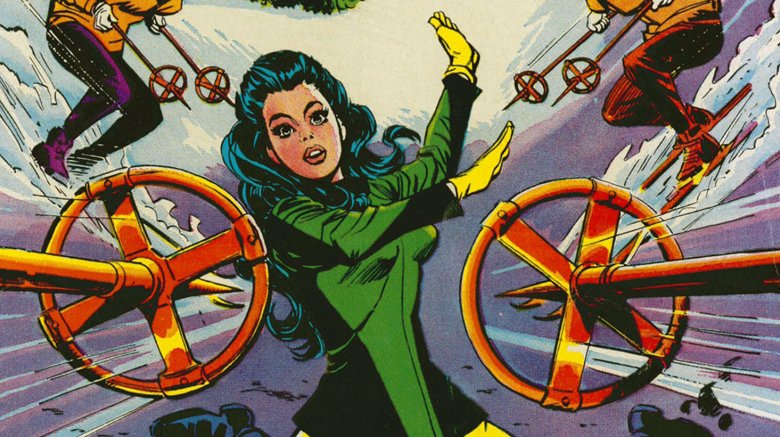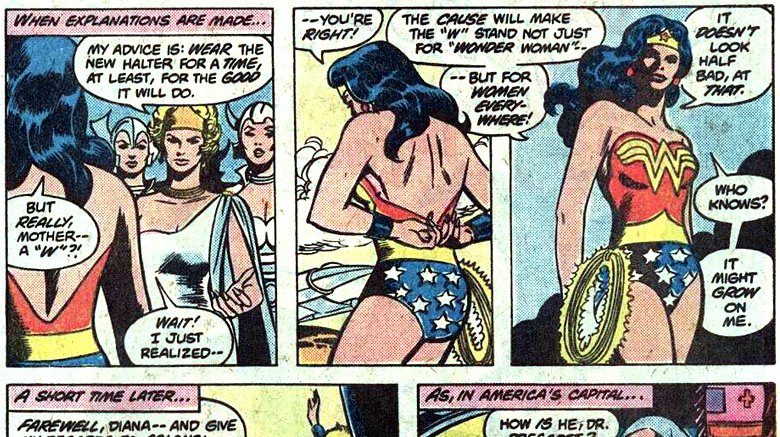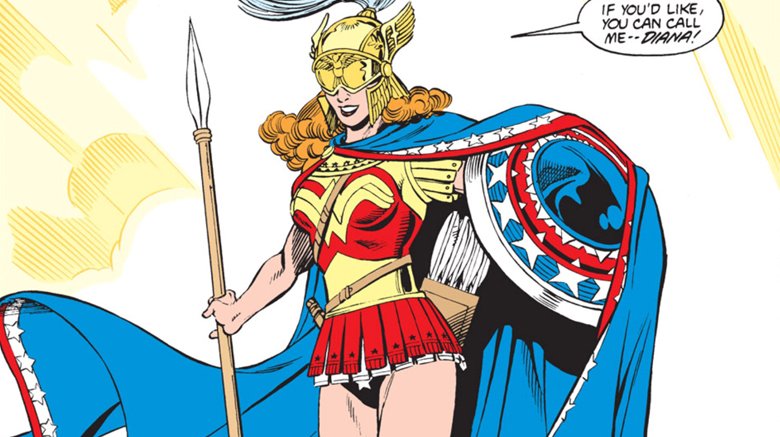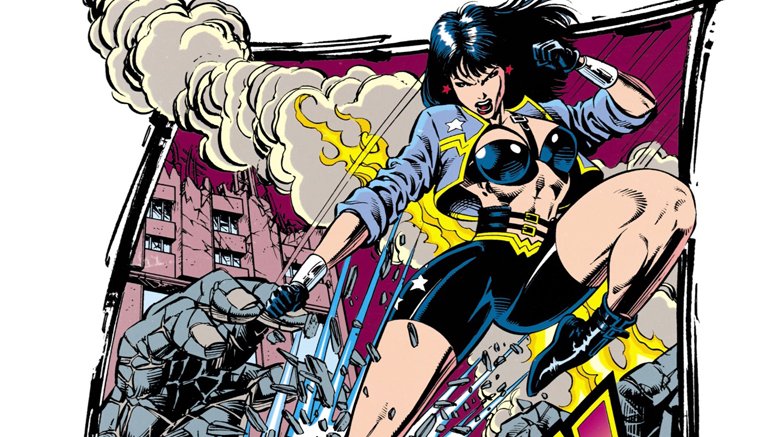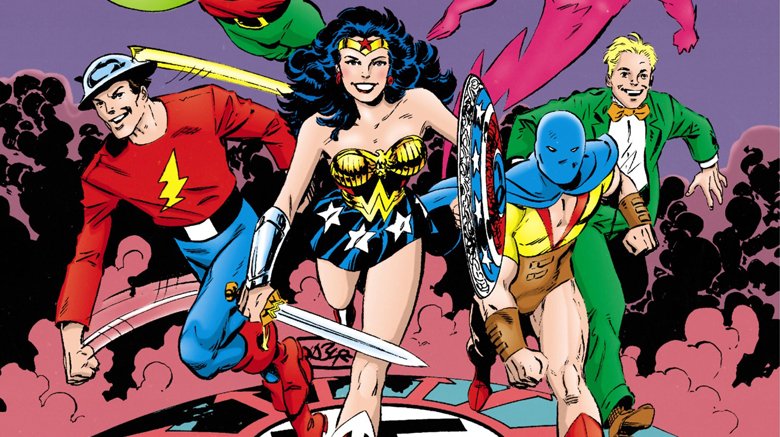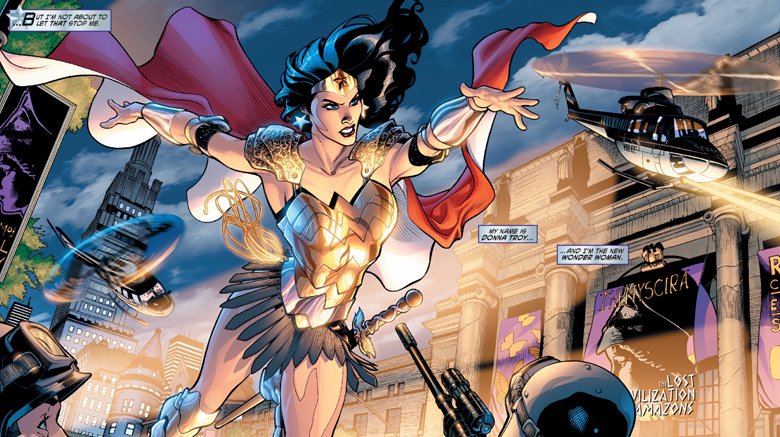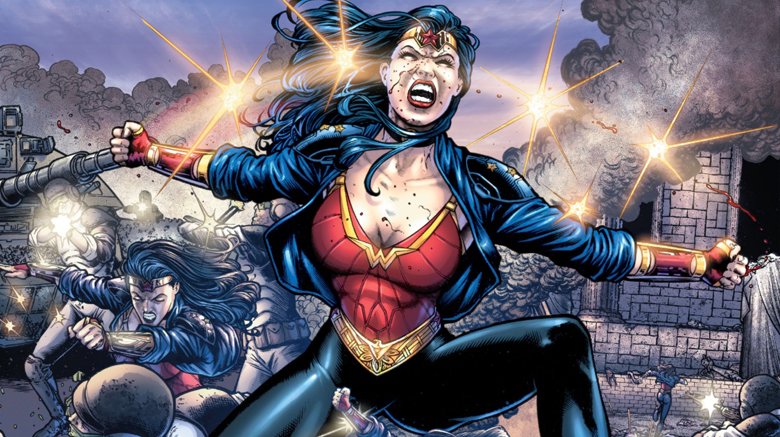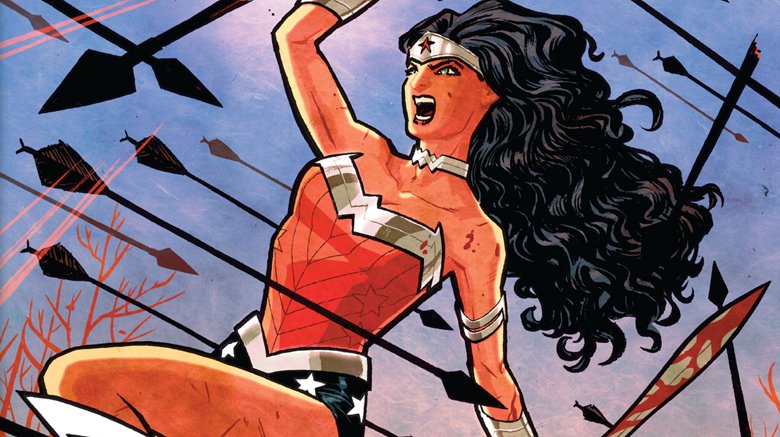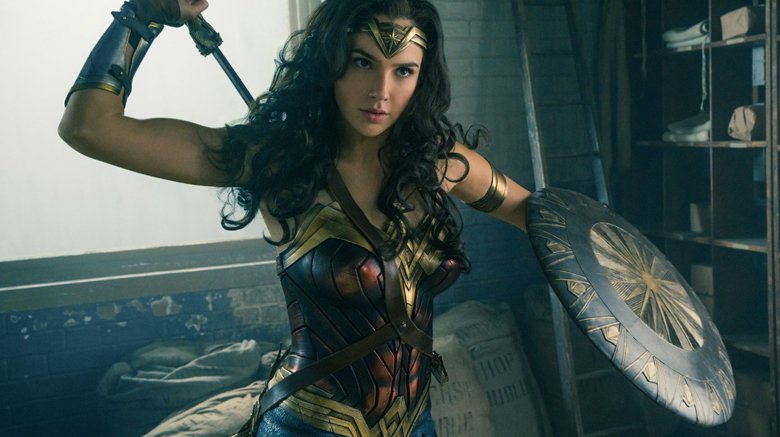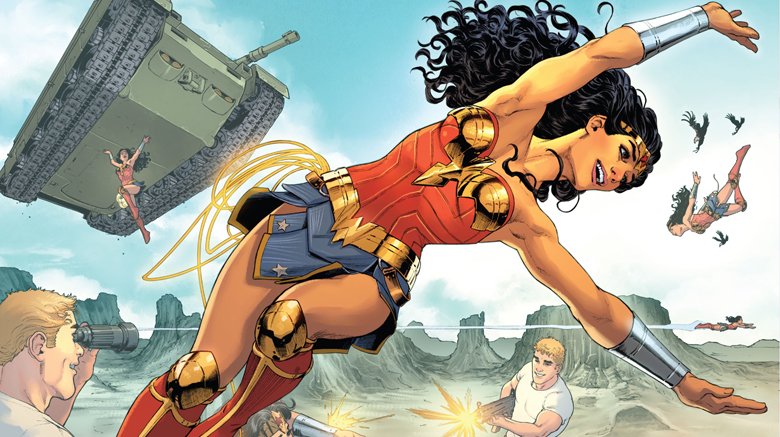The Untold Truth Of Wonder Woman's Costume
By now there's a good chance you've seen the new Wonder Woman movie. And if you only know the character from cartoons and maybe the Lynda Carter TV series, you may have some questions about her new look. Is this armored Amazon merely redesigned to look tough for the gritty DC movie aesthetic, or is her costume based on anything she's worn in the past 76 years of comic books? The short answer is "some of both," but for a longer answer we'll need to take a tour of the most important changes to Wonder Woman's costume as it's evolved—along with her character—since she made her debut during the Second World War.
The original costume
When Wonder Woman first appeared in All-Star Comics #8 in 1941, she was already pretty recognizable as basically the same hero she is today, in a distinctive costume designed by Harry G. Peter. Gold tiara, wristbands, red strapless top decorated with a golden eagle, red boots, and blue culottes spangled with white stars. Yes, that's right: culottes. Most people think she wore a skirt in her early appearances, but it's actually quite clear in Peter's art that she's wearing loose, wide-legged shorts. All the better for leaping through the air, riding kangaroos, and dropkicking Nazis. Over the course of the 1940s, the culottes became shorter and tighter until they more closely resembled a swimsuit bottom of the era.
In those World War II comics, nobody was inclined to question why Wonder Woman was dressed like the American flag with an eagle emblem when she wasn't even from the United States. In that first story, Queen Hippolyta explains that the costume has been designed to make her a hero in America—a country that the Amazons, despite their dedicated isolationism, view as a bastion of freedom and democracy.
For William Moulton Marston, Wonder Woman's original writer and credited creator, the motives behind this heavy-handed patriotism were probably a little more complex. Marston had radical ideas about gender roles and sexuality, and he deliberately channeled them into his comics. Literally wrapping his lead character in the flag was something a of defensive measure, ensuring she was palatable for mainstream America even as he slipped in more subversive messages.
A sanitized post-war version
When Marston died in 1947, the radicalism of Wonder Woman died with him—or at least went to sleep for the next few decades. Under writer Bob Kanigher and artists including Ross Andru, the Wonder Woman of the '50s and '60s reflected the gender roles of the day. She was still a hero, to be sure, but if that wasn't her honor-bound duty, she made it quite clear that she'd just as soon marry Steve Trevor and settle down to cook dinner and raise a family.
As Wonder Woman became more typically feminine by the standards of the day, her costume evolved to match. Her red boots were replaced with ballet slippers, her hair became more restrained beneath her tiara, and her swimsuit-esque costume became more demure, expanding to eliminate any hint of cleavage or thigh.
No costume, just fashion
In the late 1960s, mainstream society's views of women had begun to evolve. The feminist Wonder Woman of the '40s might have seemed less out of place now, but the more recent love-starved Wonder Woman was suddenly very dated. Rather than return the character to her roots, DC decided to take her in a whole new direction. Writer/artist Mike Sekowsky, with some initial help from writer Dennis O'Neil, did away with Wonder Woman's costume entirely, along with her superpowers. From 1968 until 1972, she became a fashionable globetrotting adventurer inspired by Emma Peel, the popular character played by Diana Rigg on the TV show The Avengers (no relation to the Marvel super-team).
In this period, Wonder Woman went by her civilian alias of Diana Prince, and wore a different outfit in basically every issue, favoring mod fashions and often (but not always) the color white. She even opened her own stylish boutique in Greenwich Village, spreading the gospel of high fashion in between her battles with Dr. Cyber and Morgana the Witch.
Wonder Woman started her journey back to the status quo after Gloria Steinem put her on the cover of the first issue of Ms.
in 1972—in her classic costume—and wrote about the importance of the character specifically as a female superhero, something she hadn't technically been in nearly four years. Calls for a return to her earlier incarnation intensified, and soon Diana Prince reunited with the Amazons, regained her superpowers, and put her classic costume on once more.
A new logo
That costume received an important update in 1982. DC President Jenette Kahn wanted to finally give Wonder Woman her own insignia along the lines of Superman's S-shield and Batman's black bat on a yellow background. She'd always had that eagle on her costume, but it was never distinctive enough to represent her—the eagle is a bit overused as a symbol, after all. So Kahn brought in graphic designer Milton Glaser, who had previously created the "DC bullet" logo that appeared on all their comics. Glaser designed a double-W with wings to replace the eagle, and it's been a symbol of the character ever since.
In the comics, Wonder Woman is given the new top with the W by a group known as the Wonder Woman Foundation, who ask her to collaborate with them to help raise money to benefit women in need around the world. She's at first reluctant to wear her own initials, but after a discussion with her mother Hippolyta, she realizes that the W can stand not just for her, but for all women.
A different Diana
After the DC Universe was rebooted in the Crisis on Infinite Earths crossover, writer/artist George Pérez was brought in to relaunch Wonder Woman in 1987. He left her costume very much the same, W-logo and all, but he gave it a new origin within the story. The idea that an Amazon would wear American colors just because America is awesome didn't make as much sense as it had back in the '40s.
According to Pérez, the Wonder Woman costume was inspired by a woman the Amazons revered as a great hero. In the 1940s, a female American pilot named Diana Trevor crashed on the Amazon island of Themyscira, and sacrificed her life helping the Amazons defeat a threat from the underworld. She passed on her first name to the Princess of the Amazons who would grow up to be Wonder Woman, and her last name to her son, Steve Trevor, who would later crash on that same island to bring things full circle. It was a convoluted story, but the mythical style in which Pérez was working made it fit. Diana Trevor even meets Princess Diana in the underworld, appearing in an armored version of the Wonder Woman costume. Wonder Woman would later wear similar armor in the War of the Gods storyline, but it wouldn't become a regular part of her look for another couple of decades.
Going full '90s
In the 1990s, the trend at DC was to put all the big superheroes in dire straits and let somebody else take over the role. Superman died, making room for four replacements. Bane broke Batman's back, forcing violent new hero Azrael to take up the Batsuit. Hal Jordan became a villain, leaving Kyle Raynor as the Green Lantern of Earth. And in a storyline by Bill Messner-Loebs and Mike Deodato, Wonder Woman lost a contest against an upstart Amazon named Artemis, who won the name and costume of Wonder Woman.
Princess Diana didn't stop being a hero, of course. She just fought the good fight in biker shorts, a strappy bikini top, a bolero jacket, and no less than three belts. It was, in short, the most '90s of looks. She even got a shorter haircut with bangs to complete the aesthetic. Naturally, she got her title and the costume that goes with it back after a few months, and her hair even grew back out as soon as she put it on.
Hippolyta's sword
A few years later, Diana again stopped being Wonder Woman, but this was because she ascended to godhood and departed the Earthly realm for Mount Olympus. Her mother her took over as Wonder Woman, in a story written and drawn by comics legend John Byrne. Hippolyta's Wonder Woman costume brought back the eagle, but made it more like armor than a simple insignia. The W logo was moved to her belt. She also wore a skirt and carried a sword and shield instead of a lasso.
Queen Hippolyta's time in costume is rarely discussed anymore, but some of the choices Byrne made in her design—the skirt, the armored eagle, the W-belt, the sword and shield—have had a lasting impact on Wonder Woman's aesthetic.
Donna's armor
The Infinite Crisis crossover shook up the DC Universe in 2006—not least with another new Wonder Woman in the form of Donna Troy, Diana's adopted sister of sorts, who was once Wonder Girl of the Teen Titans. As the star of a relaunched Wonder Woman series written by Allan Heinberg with art by Terry and Rachel Dodson, Donna wore a fully armored costume with a gladiator skirt and a sword on her belt. Again, these elements would influence Wonder Woman's design long after Donna left the role. The gladiator skirt in particular, first seen on Pérez's Diana Trevor, is an element that's resurfaced repeatedly in recent years.
Diana's pants
After Diana regained and wore the classic costume for a few more years, DC decided she needed an update in 2010. Writer J. Michael Straczynski and artist Don Kramer teamed up for a storyline called "Odyssey," which would rewrite Diana's history and send her on a quest to restore her past. Jim Lee designed a new costume for the occasion.
For the first time, Wonder Woman wore long (albeit very tight) pants. She also wore a leather jacket over a red sleeveless (but not strapless) top featuring a toned-down version of the W logo and a choker. And once again, like her mother had years earlier, she carried a sword and shield.
Reactions to the costume were mixed. A lot of fans liked seeing Wonder Woman in something less like a swimsuit and a bit more like clothing a real woman might wear, but the jacket felt a bit dated. It also didn't help that the storyline didn't go over particularly well with readers. In any case, it wouldn't matter for long, because a huge change was in the air for the entire DC Universe.
Armored in silver
In 2011, DC continuity was completely rebooted, and their entire line was relaunched with 52 new #1 issues. The New 52, as it was called, featured a Wonder Woman series written by Brian Azzarello, with gorgeous art by Cliff Chiang. Once again, Jim Lee redesigned Wonder Woman's costume, as he did for all of DC's major superheroes in the relaunch.
Interestingly, advance artwork for the New 52 showed Wonder Woman again wearing long pants, but when the book was released her legs were bare in the style of the classic costume. There was clearly some behind-the-scenes conflict over whether to keep her in pants, but readers could only speculate who'd taken which side.
The final version of this costume is both immediately recognizable as Wonder Woman and quite different from the classic version. The yellow/gold that was prevalent in every previous incarnation was now absent. Wonder Woman's tiara, belt, and W logo were all silver, like her bracelets. Interestingly, the red of her top was textured in a way that made it look like thick armor rather than fabric. This was par for the course with Lee's New 52 designs, but in Wonder Woman's case you could argue it had a more lasting impact. This series was also the first time it was fully normalized for Princess Diana as Wonder Woman to carry a sword. In a relatively short time, it became a part of her iconography as much as her long-present lasso.
The movie look
We caught our first glimpse of Gal Gadot as Wonder Woman in July of 2014, in a promo image for Batman v Superman: Dawn of Justice. Although the colors on that first image were dark and muddy, later photos gave us a better sense of the costume. The top is dark red and armored, like the New 52 design. The bottom is a blue gladiator skirt, but the length is uneven in a way that emphasizes her legs. She has the W logo on her belt, like Hippolyta's costume, although there's another W layered into the eagle design on her chest. Her tiara points down rather than up as it traditionally has in the comics. And of course, she carries a sword and a shield, in addition to the magic lasso. The costume brings in elements of many past comic book designs, although it also makes some new choices. And inevitably, things would soon come full circle.
Back around to comics
In 2016, the DC Rebirth event revamped the DC comics line once again, promising a return to classic elements missing from the New 52. Wonder Woman got a new series by writer Greg Rucka, who previously had a fan favorite run on the character more than a decade earlier, and artists Liam Sharp and Nicola Scott. She also got a new costume designed by Tony Daniel, with some tweaks by Sharp and Scott. This design is basically a comics-friendly take on the movie costume.
Scott's version, worn early in Diana's career, adds some five-pointed stars to the tiara and skirt, to bring it closer to the classic aesthetic, but Sharp's contemporary suit leaves those out, making it more like the movie look. Both outfits feature the uneven gladiator skirt, the eagle on an armored top, and the W built into the belt. Sharp's version even features the downward-pointed tiara, although Scott draws a more classic comics tiara.
For longtime comics readers, it can be irritating to see a favorite character revamped to resemble a movie, as if the comics aren't what really matter. But as a Wonder Woman costume, this one is hard to argue with. Princess Diana looks like a classical Amazon warrior living in modern times, while also looking like a superhero. She's recognizable as the same character she's been since 1941, without being beholden to those outdated aesthetics. And for anyone who doesn't like this costume, we can only advise patience. Wonder Woman and what she wears will surely evolve in the years to come—just as they have in these past seven and a half decades.
